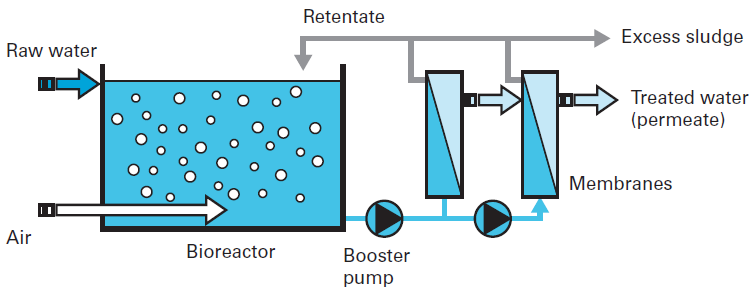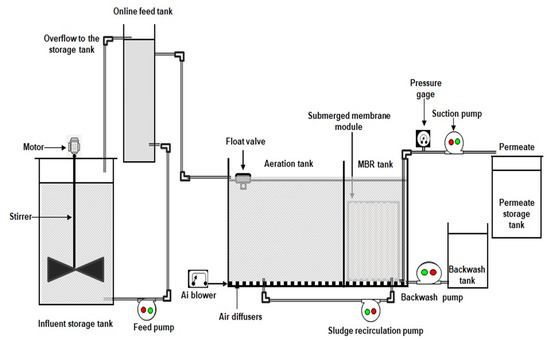Membrane Bioreactor as a Sustainable Solution for High-Volume Wastewater Treatment
Membrane Bioreactor as a Sustainable Solution for High-Volume Wastewater Treatment
Blog Article
Just How Membrane Bioreactors Are Changing Water Purification Equipments
The emergence of membrane layer bioreactors (MBRs) stands for a considerable advancement in the area of water filtration, merging biological treatment processes with sophisticated membrane filtering technologies. This combination not just enhances the top quality of dealt with effluent however additionally addresses urban area constraints, making MBRs particularly appropriate for largely booming locations. As worldwide water deficiency magnifies, the duty of MBRs in helping with potable water reuse and sustainable water administration becomes progressively important. Yet, the effects of this technology prolong beyond effectiveness-- what possibilities and challenges lie ahead for its extensive execution?
Overview of Membrane Bioreactors
Membrane layer bioreactors (MBRs) stand for a considerable development in water purification innovation, as they incorporate biological treatment procedures with membrane filtration. This integration improves the effectiveness of wastewater treatment by using microbes to weaken natural contaminants while simultaneously utilizing semi-permeable membrane layers to separate treated water from put on hold virus and solids.
The MBR system commonly contains a biological activator where the microbial populace metabolizes impurities, adhered to by a membrane layer filtering unit that preserves biomass and allows just clean water to pass through. This dual performance leads to higher effluent high quality contrasted to traditional therapy methods. MBRs can be operated in both batch and continuous flow settings, offering flexibility in style and application.
In Addition, MBRs are identified by their portable impact, making them ideal for urban setups with space restrictions. Membrane Bioreactor. They also allow the healing of water for reuse, therefore adding to water sustainability campaigns. While MBR technology has actually obtained appeal in metropolitan and industrial applications, its functional complexities and energy needs necessitate mindful consideration throughout implementation. Generally, MBRs go to the center of enhancing water therapy efficiency and top quality, showcasing the potential for innovative services in environmental administration.
Advantages of MBR Modern Technology
The assimilation of biological treatment with membrane purification provides various benefits for water purification processes. Among the key benefits of Membrane layer Bioreactor (MBR) modern technology is its capacity to effectively get rid of both not natural and organic contaminants, bring about premium effluent. The membranes work as a physical barrier, protecting against suspended solids and virus from travelling through, which enhances the overall safety and integrity of cured water.
Furthermore, MBR systems need a smaller sized footprint contrasted to traditional treatment methods, permitting more reliable area use. This portable style is specifically beneficial in metropolitan settings where land is limited. MBRs additionally show operational flexibility, accommodating varying influent top qualities and circulation prices without significant efficiency degradation.
Furthermore, the process uses enhanced nutrient removal abilities, particularly for nitrogen and phosphorus, which are vital for avoiding eutrophication in getting waters. The lowered sludge manufacturing connected with MBR modern technology also translates to decrease disposal costs, making it an economical solution over time - Membrane Bioreactor. Generally, the benefits of MBR innovation position it as a leading option for ingenious and lasting water purification systems, addressing both ecological and financial issues
Applications in Water Filtration
Applications of Membrane Bioreactor (MBR) technology in water filtration are varied and impactful, addressing various therapy requires throughout numerous industries. MBRs properly incorporate biological therapy procedures with membrane filtration, making them suitable for metropolitan wastewater treatment, industrial effluent management, and also drinkable water reuse initiatives.
In municipal setups, MBRs are increasingly utilized to enhance the top quality of dealt with wastewater, enabling conformity with rigorous discharge regulations and helping with the recycling of water for watering and non-potable usages. Their small style additionally makes them appropriate for metropolitan environments where space is restricted.
Industrially, MBR modern technology is used to deal with process water and wastewater, particularly in fields such as food and drink, drugs, and fabrics. By successfully getting rid of contaminants and put on hold solids, MBRs help sectors minimize environmental impacts while recovering useful sources from wastewater streams.
Furthermore, MBRs are gaining grip in decentralized water therapy applications, where small-scale systems can be released in remote areas or developing regions. This flexibility makes it possible for communities to attain sustainable water management solutions, enhancing access to tidy water while minimizing dependence on traditional therapy techniques.
Study and Success Stories

In one more instance, a textile manufacturing facility in Bangladesh adopted MBR modern technology to resolve its wastewater challenges. The system decreased chemical oxygen need (COD) levels from 1,200 mg/L to less than 100 mg/L, therefore fulfilling regulative criteria and dramatically decreasing ecological influence.
The University of Cape Community's MBR installment has shown effective in treating greywater for non-potable reuse on university. This project not just conserves potable water yet likewise acts as an academic model for sustainable methods.
Moreover, a fish and shellfish handling plant in Norway used MBR innovation to treat effluents consisting of high levels of organic matter, accomplishing over 90% contaminant elimination. These study emphasize MBR innovation's flexibility and its crucial duty in enhancing water high quality across diverse applications.
Future of Water Treatment Solutions
As global water scarcity and pollution obstacles increase, cutting-edge water treatment remedies are coming to be progressively important to make sure lasting accessibility to tidy water. The future of water treatment hinges on the combination of sophisticated innovations that enhance go to these guys the effectiveness and performance of purification procedures. Membrane layer bioreactors (MBRs) go to the forefront of this development, incorporating biological therapy with membrane filtration to generate top notch effluent appropriate for different applications.

Emerging fads such as source recuperation from wastewater, consisting of nutrients and energy, will better change therapy centers right into green hubs. Furthermore, innovations in nanotechnology and membrane materials assure improved performance and durability of purification systems.

Conclusion
Their role in safe and clean water reuse and look at here now lasting water management highlights their significance in addressing worldwide water shortage difficulties. Proceeded research study and advancement will certainly additionally boost the efficacy and adoption of MBR modern technology, ensuring a resilient future for water treatment solutions.
The appearance of membrane layer bioreactors (MBRs) represents a substantial development in the field of water purification, merging biological therapy processes with sophisticated membrane filtration modern technologies. As international water deficiency magnifies, the role of MBRs in assisting in potable water reuse and sustainable water monitoring ends up being significantly essential. They additionally allow the recovery of water for reuse, hence contributing to water sustainability campaigns.As global water shortage and contamination difficulties heighten, ingenious water therapy solutions are ending up being significantly vital to guarantee lasting access to clean water. Their function in safe and clean water reuse and sustainable water administration highlights their significance in dealing with worldwide water shortage difficulties.
Report this page